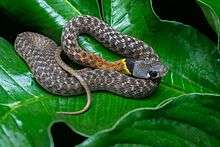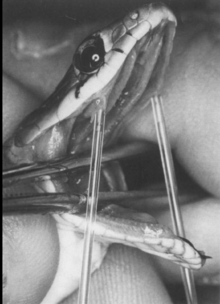Rhabdophis subminiatus
Rhabdophis subminiatus, commonly called the red-necked keelback, is a species of venomous snake in the family Colubridae. The species is endemic to Asia.
| Rhabdophis subminiatus | |
|---|---|
 | |
| Rhabdophis subminiatus | |
| Scientific classification | |
| Kingdom: | Animalia |
| Phylum: | Chordata |
| Class: | Reptilia |
| Order: | Squamata |
| Suborder: | Serpentes |
| Family: | Colubridae |
| Genus: | Rhabdophis |
| Species: | R. subminiatus |
| Binomial name | |
| Rhabdophis subminiatus (Schlegel, 1837) | |
| Synonyms[2] | |
| |
Description
R. subminiatus has a greenish hue with red and yellow regions near the head. It grows to 70 to 90 cm (27.5 to 35.5 in) in total length (including tail).
Habitat and diet
The red-necked keelback generally lives near ponds, where it consumes frogs and fish.[3]
Snakebite and venom
R. subminiatus is a rear-fanged species and was previously thought to be harmless. However, following one fatal and several near-fatal envenomations, the toxicity of its venom was investigated. As a result, it has recently been reclassified as a dangerous species. Rear-fanged snakes need to bite and hold on, or repeatedly bite, to have any effect on humans. A chewing action facilitates envenomation, as the venom ducts open to fangs that are externally grooved (not hollow) and are posterior in the oral cavity. R. subminiatus has enlarged and ungrooved teeth. The species has two enlarged teeth in the back of the jaw. Located in the upper jaw is a gland known as Duvernoy's gland, which produces an extremely venomous secretion.[3]

Symptoms caused by venom
When the snake bites, the salivary venom mixture is not injected, but it flows into the punctures produced by the upper jaw's rear teeth, which can penetrate the skin of humans. The venom from R. subminiatus has been responsible for internal hemorrhaging, including hemorrhaging of the brain, as well as nausea, coagulopathy, and even disseminated intravascular coagulation. Also, when the venom was tested on animals, kidney failure was reported. Caution should be taken when dealing with patients who have been bitten by the red-necked keelback snake. No further injury such as injections should be used because this may cause excessive bleeding in the bite victim. Although most bites of humans from R. subminiatus are involved with the front teeth and do not cause adverse effects, rare bites from the rear fangs can be lethal.[4]
Subspecies
Two subspecies are recognized as being valid, including the nominotypical subspecies.[2]
The trinomial authority in parentheses indicates that the subspecies was originally described in a genus other than Rhabdophis.
Etymology
The subspecific name, helleri, is in honor of American zoologist Edmund Heller.[5]
Geographic range
The red-necked keelback can be found in:[2]
- Indonesia (Sumatra, Borneo, Java, Sulawesi ?)
- Thailand, Vietnam, Cambodia, Laos, Burma
- West Malaysia, Bhutan, Bangladesh, Nepal
- India ( Tripura, Assam, West Bengal [Jalpaiguri district], Sikkim; Arunachal Pradesh [Chimpu, Itanagar - Papum Pare district], Mizoram [Selesih, World Bank Road])
- China (Yunnan, Guangxi, Guangdong, Fujian, Hong Kong, Hainan)
The subspecies R. s. helleri can be found in:[2]
References
- Wogan G, Chan-Ard T (2012). "Rhabdophis subminiatus ". IUCN Red List of Threatened Species. 2012: e.T192116A2042128. doi:10.2305/IUCN.UK.2012-1.RLTS.T192116A2042128.en.
- "Rhabdophis subminiatus ". The Reptile Database. www.reptile-database.org.
- Ferlan I, Ferlan A, King T, Russell FE (1983). "Preliminary studies on the venom of the colubrid snake Rhabdophis subminatus (red-necked keelback)". Toxicon. 21 (4): 570–574. doi:10.1016/0041-0101(83)90137-x.
- Zotz RB, Mebs D, Hirche H, Paar D (1991). "Hemostatic changes due to the venom gland extract of the red-necked keelback snake (Rhabdophis subminiatus)". Toxicon. 29 (12): 1501–1508. doi:10.1016/0041-0101(91)90006-d.
- Schmidt, Karl P. (1925). "New reptiles and a new salamander from China". American Museum Novitates (157): 1-5. http://digitallibrary.amnh.org/dspace/handle/2246/9
External links
| Wikimedia Commons has media related to Rhabdophis subminiatus. |
Further reading
- Boulenger GA (1893). Catalogue of the Snakes in the British Museum (Natural History). Voume I., Containing the Families ... Colubridæ Aglyphæ, part. London: Trustees of the British Museum (Natural History). (Taylor and Francis, printers). xiii + 448 pp. + Plates I-XXVIII. (Tropidonotus subminiatus, pp. 256–257).
- Bulian J (1999). "Über die Schlangenfauna eines Gartens in Südthailand ". Elaphe 7 (4): 61-67. (in German).
- Das I (2002). A Photographic Guide to Snakes and other Reptiles of India. Sanibel Island, Florida: Ralph Curtis Books, 144 pp. ISBN 0-88359-056-5. (Rhabdophis subminiatus, p. 44).
- Schlegel H (1837). Essai sur la physionomie des serpens. Partie Générale. xxviii + 251 pp. + Partie Descriptive. 606 + xvi pp. Amsterdam: M.H. Schonekat. (Tropidonotus subminiatus, new species, pp. 313–314 in Partie Descriptive). (in French).
- Schmidt KP (1925). "New Reptiles and a New Salamander from China". American Museum Novitates (157): 1-5. (Natrix helleri, new species, p. 3).
- Smith MA (1943). The Fauna of British India, Ceylon and Burma, Including the Whole of the Indo-Chinese Sub-region. Reptilia and Amphibia. Vol. III.—Serpentes. London: Secretary of State for India. (Taylor and Francis, printers). xii + 583 pp. (Natrix subminiata, pp. 302–303).
